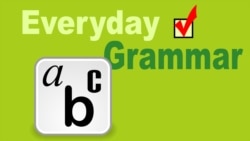If you read or listened to Part 1 of our program on comparisons of equality, you know that we can compare equal qualities and actions by using the word “as.” We can also compare equal quantities, or amounts, and we will talk about that on today’s Everyday Grammar program.
Because of how we form equal comparisons, I will call them “as…as comparisons.”
Comparing equal quantities
Suppose you are playing a card game with two friends. The goal is to have no cards remaining. You look and see that the other players each have the same number of cards.
In English, there are a few ways to express an equal number or quantity between two things.
One way is to make an as…as comparison. Here is what someone might say or write:
Ayami has as many cards as Zora.
Let's examine this sentence. There is a subject and verb. Notice also that the word “as” is used two times and note where it is placed: before and after the thing being compared.
The structure for comparisons of quantity goes like this:
as + many (or) much + noun + as
In the example, “many” is the quantity word and “cards” is the noun.
You may recall that, for countable nouns, like “cards,” we use the word “many.” For uncountable nouns, like “money,” we use the word “much.”
Now, suppose you all are getting hungry. You want to order food to be delivered and want your friends to share in the cost. So, you ask them how much money they each can spend, and they both can spend an equal amount. To express it with an as…as comparison, you could say this:
Ayami can spend as much money as Zora.
Notice that the word “much” is used with the noun “money” because “money” is an uncountable noun.
Sometimes, in these kinds of comparisons, native English speakers may replace the noun with a pronoun. So, instead of saying “much money,” they might use “much” as a pronoun. Here is what that sounds like:
Ayami can spend as much as Zora.
Use of the pronoun suggests the listener already knows that money is being discussed.
So far, we have put people in the examples. But we can also make quantity comparisons between two things.
Suppose you are looking for a table with a lot of style. You visit a furniture store and see two tables that seem equally stylish. Here is one way to express it:
This table has as much style as that table.
Here, you are comparing amounts of style, and “style” is an uncountable noun.
Unequal quantities
We have talked about expressing equal quantities or amounts. But what happens when the quantities are not equal? In as…as comparisons, we use the negative form.
Let’s return to the card game example. Suppose your friends do not have the same number of cards. How could you express the unequal quantity?
Ayami does not have as many cards as Zora.
Now, let’s hear the example about the friends’ food budgets:
Ayami cannot spend as much money as Zora.
Most likely, a native English speaker would use the shortened version, “can’t.” Here is how that would sound:
Ayami can’t spend as much money as Zora.
Again, a native speaker might also replace “ money” with just the pronoun “much,” like this:
Ayami can’t spend as much as Zora.
Now, what about the tables? How could you say their style is not equal? Like this:
This table does not have as much style as that table.
Why as…as comparisons?
By now, you might be thinking, “But there are other ways to say things are equal or unequal.” You are right! For example, you could use the word “both,” as in, “Ayami and Zora can both spend $20.” Or, to show an unequal amount, you could say, “Zora can spend more than Ayami.”
So why, then, do we use as…as comparisons? The answer is for emphasis.
These comparisons bring emphasis to the fact that the first thing (which is the subject) is equal to or the same in some way to the second thing.
Look and listen for these comparisons wherever English is being used. Ask yourself who or what is being compared. Then think about whether it is a comparison of qualities, actions, or amounts.
I’m Alice Bryant.
Alice Bryant wrote this story for Learning English. George Grow was the editor.
________________________________________________________________
Words in This Story
card - n. a small piece of stiff paper that is marked with symbols or pictures and is used for playing games
deliver - v. to take something to a person or place
pronoun - n. a word that is used instead of a noun
style - n. a particular form or design of something
furniture - n. chairs, tables, beds, etc., that are used to make a room ready for use
negative - adj. expressing dislike or refusal
emphasis - n. special importance or attention given to something










